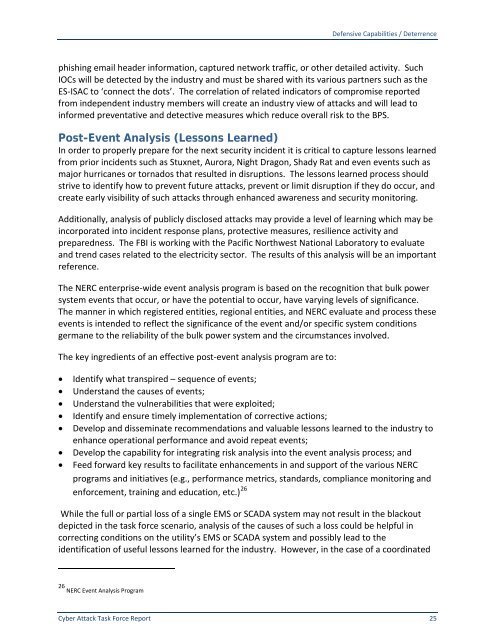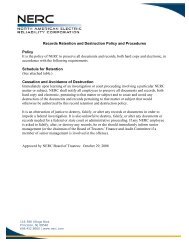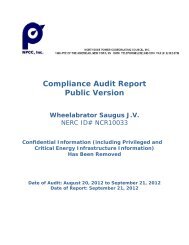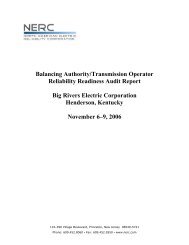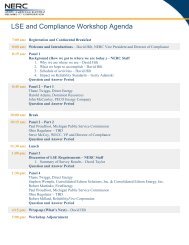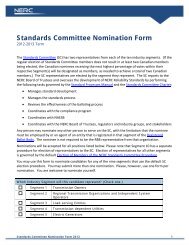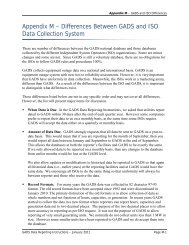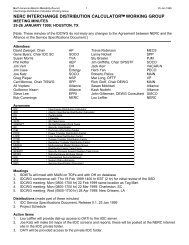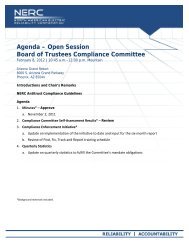Cyber Attack Task Force - Final Report - NERC
Cyber Attack Task Force - Final Report - NERC
Cyber Attack Task Force - Final Report - NERC
Create successful ePaper yourself
Turn your PDF publications into a flip-book with our unique Google optimized e-Paper software.
Defensive Capabilities / Deterrence<br />
phishing email header information, captured network traffic, or other detailed activity. Such<br />
IOCs will be detected by the industry and must be shared with its various partners such as the<br />
ES-ISAC to ‘connect the dots’. The correlation of related indicators of compromise reported<br />
from independent industry members will create an industry view of attacks and will lead to<br />
informed preventative and detective measures which reduce overall risk to the BPS.<br />
Post-Event Analysis (Lessons Learned)<br />
In order to properly prepare for the next security incident it is critical to capture lessons learned<br />
from prior incidents such as Stuxnet, Aurora, Night Dragon, Shady Rat and even events such as<br />
major hurricanes or tornados that resulted in disruptions. The lessons learned process should<br />
strive to identify how to prevent future attacks, prevent or limit disruption if they do occur, and<br />
create early visibility of such attacks through enhanced awareness and security monitoring.<br />
Additionally, analysis of publicly disclosed attacks may provide a level of learning which may be<br />
incorporated into incident response plans, protective measures, resilience activity and<br />
preparedness. The FBI is working with the Pacific Northwest National Laboratory to evaluate<br />
and trend cases related to the electricity sector. The results of this analysis will be an important<br />
reference.<br />
The <strong>NERC</strong> enterprise-wide event analysis program is based on the recognition that bulk power<br />
system events that occur, or have the potential to occur, have varying levels of significance.<br />
The manner in which registered entities, regional entities, and <strong>NERC</strong> evaluate and process these<br />
events is intended to reflect the significance of the event and/or specific system conditions<br />
germane to the reliability of the bulk power system and the circumstances involved.<br />
The key ingredients of an effective post-event analysis program are to:<br />
• Identify what transpired – sequence of events;<br />
• Understand the causes of events;<br />
• Understand the vulnerabilities that were exploited;<br />
• Identify and ensure timely implementation of corrective actions;<br />
• Develop and disseminate recommendations and valuable lessons learned to the industry to<br />
enhance operational performance and avoid repeat events;<br />
• Develop the capability for integrating risk analysis into the event analysis process; and<br />
• Feed forward key results to facilitate enhancements in and support of the various <strong>NERC</strong><br />
programs and initiatives (e.g., performance metrics, standards, compliance monitoring and<br />
enforcement, training and education, etc.) 26<br />
While the full or partial loss of a single EMS or SCADA system may not result in the blackout<br />
depicted in the task force scenario, analysis of the causes of such a loss could be helpful in<br />
correcting conditions on the utility’s EMS or SCADA system and possibly lead to the<br />
identification of useful lessons learned for the industry. However, in the case of a coordinated<br />
26 <strong>NERC</strong> Event Analysis Program<br />
<strong>Cyber</strong> <strong>Attack</strong> <strong>Task</strong> <strong>Force</strong> <strong>Report</strong> 25


